Critical Evaluation of Corporate Governance in the UK: Laws and Code
VerifiedAdded on 2022/10/04
|12
|3255
|13
Report
AI Summary
This report provides a critical evaluation of the development of corporate governance in the United Kingdom. It begins with an introduction to corporate governance, its evolution, and its importance in balancing social and economic aims, ensuring effective resource use, and aligning stakeholders' benefits. The report discusses the agency theory, the legal separation of companies, and the duties of directors. It then focuses on the UK Corporate Governance Code 2018, its principles, and its application to public and private limited companies. The report examines the importance of corporate governance in mitigating conflicts of interest and promoting transparency within businesses. Key legal cases such as Green v Bestobell Industries Pty Ltd, Salomon v A Salomon & Co Ltd, and Gilford Motor Co Ltd v Horne are discussed to illustrate the principles of corporate governance. The report concludes with an analysis of the code's principles regarding leadership, purpose, board composition, and remuneration, emphasizing the need for sustainable corporate success and stakeholder engagement. The report highlights how the UK Corporate Governance Code 2018 sets higher standards for companies, promoting integrity, transparency, and long-term investment.
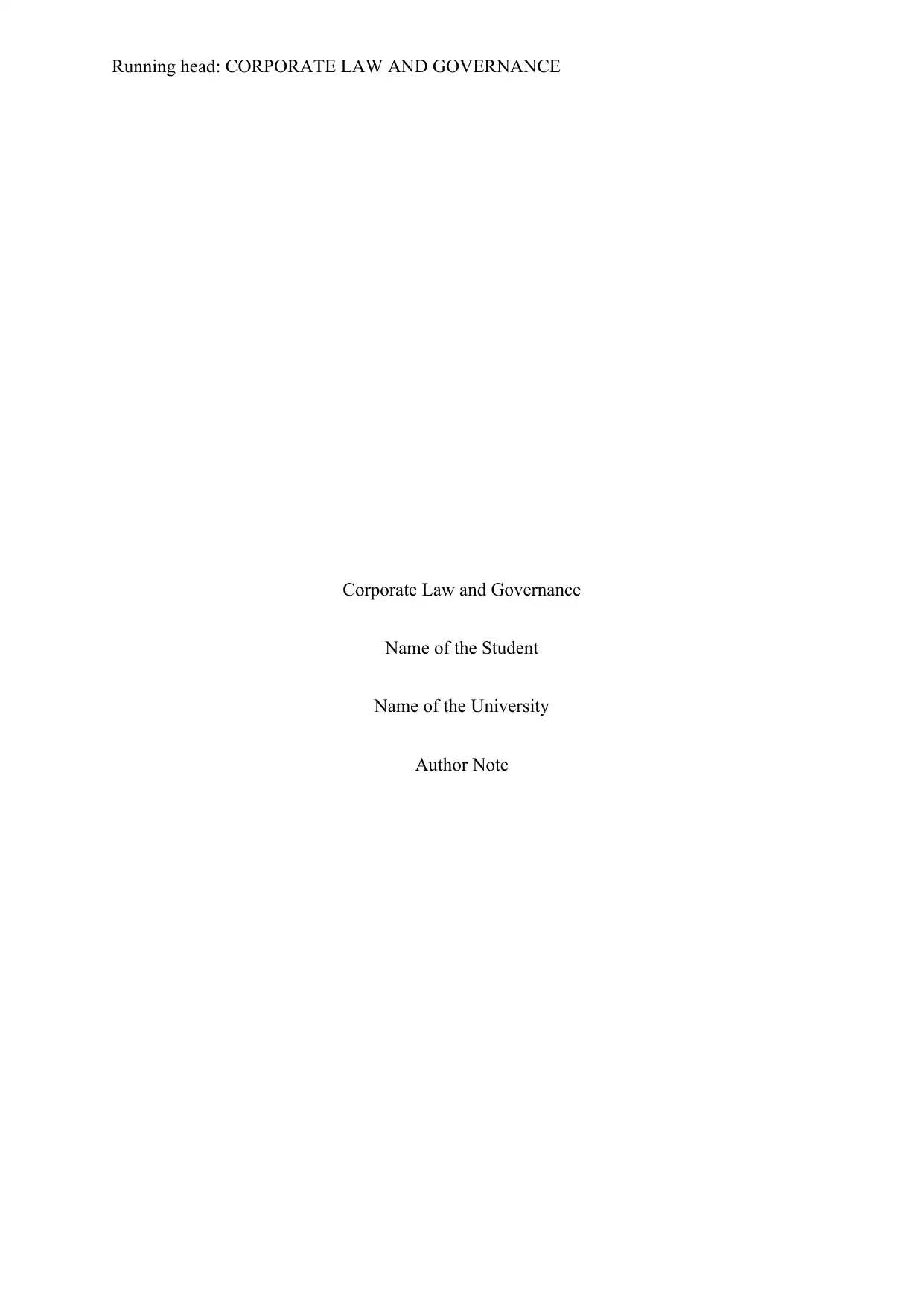
Running head: CORPORATE LAW AND GOVERNANCE
Corporate Law and Governance
Name of the Student
Name of the University
Author Note
Corporate Law and Governance
Name of the Student
Name of the University
Author Note
Paraphrase This Document
Need a fresh take? Get an instant paraphrase of this document with our AI Paraphraser
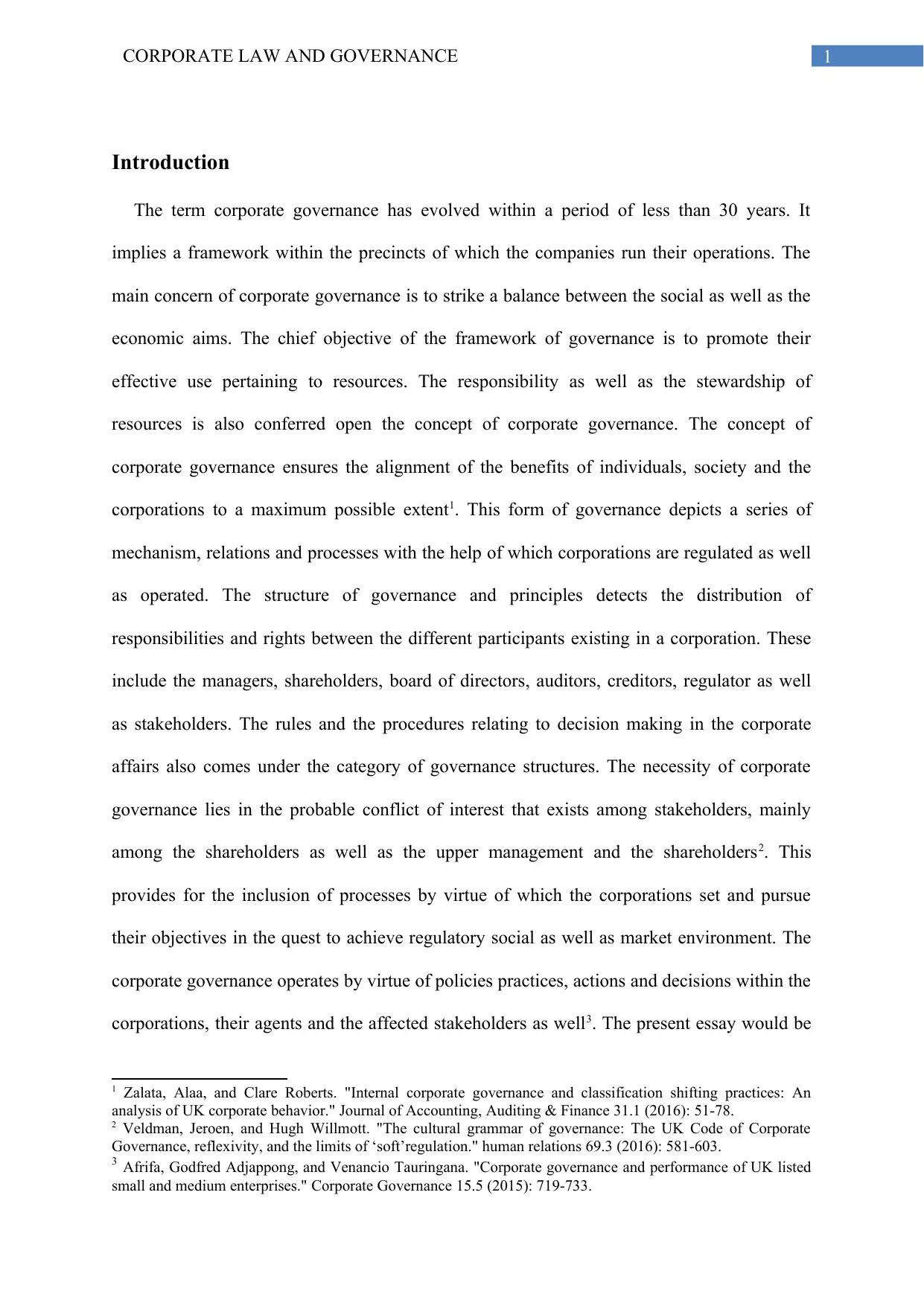
1CORPORATE LAW AND GOVERNANCE
Introduction
The term corporate governance has evolved within a period of less than 30 years. It
implies a framework within the precincts of which the companies run their operations. The
main concern of corporate governance is to strike a balance between the social as well as the
economic aims. The chief objective of the framework of governance is to promote their
effective use pertaining to resources. The responsibility as well as the stewardship of
resources is also conferred open the concept of corporate governance. The concept of
corporate governance ensures the alignment of the benefits of individuals, society and the
corporations to a maximum possible extent1. This form of governance depicts a series of
mechanism, relations and processes with the help of which corporations are regulated as well
as operated. The structure of governance and principles detects the distribution of
responsibilities and rights between the different participants existing in a corporation. These
include the managers, shareholders, board of directors, auditors, creditors, regulator as well
as stakeholders. The rules and the procedures relating to decision making in the corporate
affairs also comes under the category of governance structures. The necessity of corporate
governance lies in the probable conflict of interest that exists among stakeholders, mainly
among the shareholders as well as the upper management and the shareholders2. This
provides for the inclusion of processes by virtue of which the corporations set and pursue
their objectives in the quest to achieve regulatory social as well as market environment. The
corporate governance operates by virtue of policies practices, actions and decisions within the
corporations, their agents and the affected stakeholders as well3. The present essay would be
1 Zalata, Alaa, and Clare Roberts. "Internal corporate governance and classification shifting practices: An
analysis of UK corporate behavior." Journal of Accounting, Auditing & Finance 31.1 (2016): 51-78.
2 Veldman, Jeroen, and Hugh Willmott. "The cultural grammar of governance: The UK Code of Corporate
Governance, reflexivity, and the limits of ‘soft’regulation." human relations 69.3 (2016): 581-603.
3 Afrifa, Godfred Adjappong, and Venancio Tauringana. "Corporate governance and performance of UK listed
small and medium enterprises." Corporate Governance 15.5 (2015): 719-733.
Introduction
The term corporate governance has evolved within a period of less than 30 years. It
implies a framework within the precincts of which the companies run their operations. The
main concern of corporate governance is to strike a balance between the social as well as the
economic aims. The chief objective of the framework of governance is to promote their
effective use pertaining to resources. The responsibility as well as the stewardship of
resources is also conferred open the concept of corporate governance. The concept of
corporate governance ensures the alignment of the benefits of individuals, society and the
corporations to a maximum possible extent1. This form of governance depicts a series of
mechanism, relations and processes with the help of which corporations are regulated as well
as operated. The structure of governance and principles detects the distribution of
responsibilities and rights between the different participants existing in a corporation. These
include the managers, shareholders, board of directors, auditors, creditors, regulator as well
as stakeholders. The rules and the procedures relating to decision making in the corporate
affairs also comes under the category of governance structures. The necessity of corporate
governance lies in the probable conflict of interest that exists among stakeholders, mainly
among the shareholders as well as the upper management and the shareholders2. This
provides for the inclusion of processes by virtue of which the corporations set and pursue
their objectives in the quest to achieve regulatory social as well as market environment. The
corporate governance operates by virtue of policies practices, actions and decisions within the
corporations, their agents and the affected stakeholders as well3. The present essay would be
1 Zalata, Alaa, and Clare Roberts. "Internal corporate governance and classification shifting practices: An
analysis of UK corporate behavior." Journal of Accounting, Auditing & Finance 31.1 (2016): 51-78.
2 Veldman, Jeroen, and Hugh Willmott. "The cultural grammar of governance: The UK Code of Corporate
Governance, reflexivity, and the limits of ‘soft’regulation." human relations 69.3 (2016): 581-603.
3 Afrifa, Godfred Adjappong, and Venancio Tauringana. "Corporate governance and performance of UK listed
small and medium enterprises." Corporate Governance 15.5 (2015): 719-733.
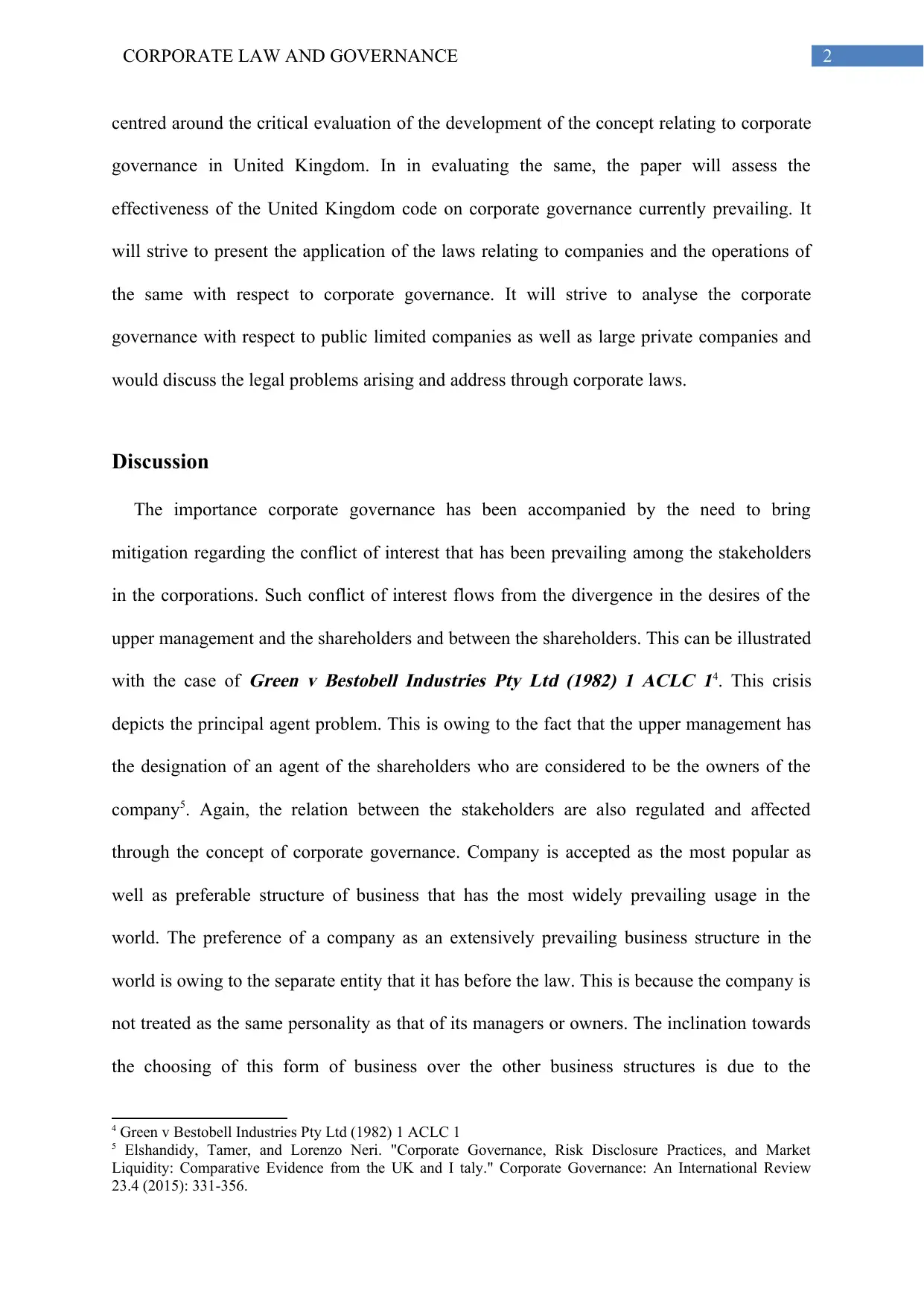
2CORPORATE LAW AND GOVERNANCE
centred around the critical evaluation of the development of the concept relating to corporate
governance in United Kingdom. In in evaluating the same, the paper will assess the
effectiveness of the United Kingdom code on corporate governance currently prevailing. It
will strive to present the application of the laws relating to companies and the operations of
the same with respect to corporate governance. It will strive to analyse the corporate
governance with respect to public limited companies as well as large private companies and
would discuss the legal problems arising and address through corporate laws.
Discussion
The importance corporate governance has been accompanied by the need to bring
mitigation regarding the conflict of interest that has been prevailing among the stakeholders
in the corporations. Such conflict of interest flows from the divergence in the desires of the
upper management and the shareholders and between the shareholders. This can be illustrated
with the case of
Green v Bestobell Industries Pty Ltd (1982) 1 ACLC 14. This crisis
depicts the principal agent problem. This is owing to the fact that the upper management has
the designation of an agent of the shareholders who are considered to be the owners of the
company5. Again, the relation between the stakeholders are also regulated and affected
through the concept of corporate governance. Company is accepted as the most popular as
well as preferable structure of business that has the most widely prevailing usage in the
world. The preference of a company as an extensively prevailing business structure in the
world is owing to the separate entity that it has before the law. This is because the company is
not treated as the same personality as that of its managers or owners. The inclination towards
the choosing of this form of business over the other business structures is due to the
4 Green v Bestobell Industries Pty Ltd (1982) 1 ACLC 1
5 Elshandidy, Tamer, and Lorenzo Neri. "Corporate Governance, Risk Disclosure Practices, and Market
Liquidity: Comparative Evidence from the UK and I taly." Corporate Governance: An International Review
23.4 (2015): 331-356.
centred around the critical evaluation of the development of the concept relating to corporate
governance in United Kingdom. In in evaluating the same, the paper will assess the
effectiveness of the United Kingdom code on corporate governance currently prevailing. It
will strive to present the application of the laws relating to companies and the operations of
the same with respect to corporate governance. It will strive to analyse the corporate
governance with respect to public limited companies as well as large private companies and
would discuss the legal problems arising and address through corporate laws.
Discussion
The importance corporate governance has been accompanied by the need to bring
mitigation regarding the conflict of interest that has been prevailing among the stakeholders
in the corporations. Such conflict of interest flows from the divergence in the desires of the
upper management and the shareholders and between the shareholders. This can be illustrated
with the case of
Green v Bestobell Industries Pty Ltd (1982) 1 ACLC 14. This crisis
depicts the principal agent problem. This is owing to the fact that the upper management has
the designation of an agent of the shareholders who are considered to be the owners of the
company5. Again, the relation between the stakeholders are also regulated and affected
through the concept of corporate governance. Company is accepted as the most popular as
well as preferable structure of business that has the most widely prevailing usage in the
world. The preference of a company as an extensively prevailing business structure in the
world is owing to the separate entity that it has before the law. This is because the company is
not treated as the same personality as that of its managers or owners. The inclination towards
the choosing of this form of business over the other business structures is due to the
4 Green v Bestobell Industries Pty Ltd (1982) 1 ACLC 1
5 Elshandidy, Tamer, and Lorenzo Neri. "Corporate Governance, Risk Disclosure Practices, and Market
Liquidity: Comparative Evidence from the UK and I taly." Corporate Governance: An International Review
23.4 (2015): 331-356.
You're viewing a preview
Unlock full access by subscribing today!
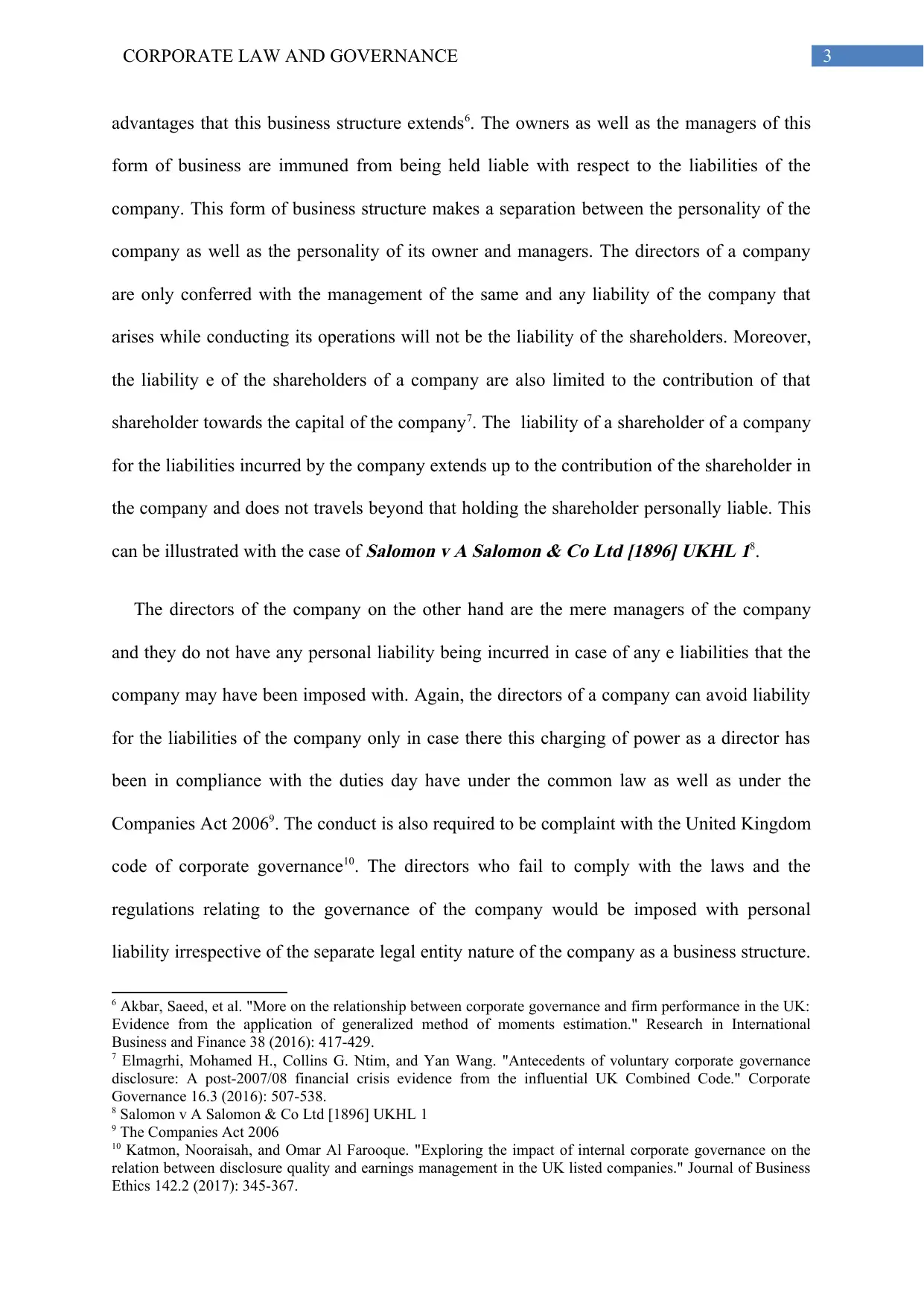
3CORPORATE LAW AND GOVERNANCE
advantages that this business structure extends6. The owners as well as the managers of this
form of business are immuned from being held liable with respect to the liabilities of the
company. This form of business structure makes a separation between the personality of the
company as well as the personality of its owner and managers. The directors of a company
are only conferred with the management of the same and any liability of the company that
arises while conducting its operations will not be the liability of the shareholders. Moreover,
the liability e of the shareholders of a company are also limited to the contribution of that
shareholder towards the capital of the company7. The liability of a shareholder of a company
for the liabilities incurred by the company extends up to the contribution of the shareholder in
the company and does not travels beyond that holding the shareholder personally liable. This
can be illustrated with the case of
Salomon v A Salomon & Co Ltd [1896] UKHL 18.
The directors of the company on the other hand are the mere managers of the company
and they do not have any personal liability being incurred in case of any e liabilities that the
company may have been imposed with. Again, the directors of a company can avoid liability
for the liabilities of the company only in case there this charging of power as a director has
been in compliance with the duties day have under the common law as well as under the
Companies Act 20069. The conduct is also required to be complaint with the United Kingdom
code of corporate governance10. The directors who fail to comply with the laws and the
regulations relating to the governance of the company would be imposed with personal
liability irrespective of the separate legal entity nature of the company as a business structure.
6 Akbar, Saeed, et al. "More on the relationship between corporate governance and firm performance in the UK:
Evidence from the application of generalized method of moments estimation." Research in International
Business and Finance 38 (2016): 417-429.
7 Elmagrhi, Mohamed H., Collins G. Ntim, and Yan Wang. "Antecedents of voluntary corporate governance
disclosure: A post-2007/08 financial crisis evidence from the influential UK Combined Code." Corporate
Governance 16.3 (2016): 507-538.
8 Salomon v A Salomon & Co Ltd [1896] UKHL 1
9 The Companies Act 2006
10 Katmon, Nooraisah, and Omar Al Farooque. "Exploring the impact of internal corporate governance on the
relation between disclosure quality and earnings management in the UK listed companies." Journal of Business
Ethics 142.2 (2017): 345-367.
advantages that this business structure extends6. The owners as well as the managers of this
form of business are immuned from being held liable with respect to the liabilities of the
company. This form of business structure makes a separation between the personality of the
company as well as the personality of its owner and managers. The directors of a company
are only conferred with the management of the same and any liability of the company that
arises while conducting its operations will not be the liability of the shareholders. Moreover,
the liability e of the shareholders of a company are also limited to the contribution of that
shareholder towards the capital of the company7. The liability of a shareholder of a company
for the liabilities incurred by the company extends up to the contribution of the shareholder in
the company and does not travels beyond that holding the shareholder personally liable. This
can be illustrated with the case of
Salomon v A Salomon & Co Ltd [1896] UKHL 18.
The directors of the company on the other hand are the mere managers of the company
and they do not have any personal liability being incurred in case of any e liabilities that the
company may have been imposed with. Again, the directors of a company can avoid liability
for the liabilities of the company only in case there this charging of power as a director has
been in compliance with the duties day have under the common law as well as under the
Companies Act 20069. The conduct is also required to be complaint with the United Kingdom
code of corporate governance10. The directors who fail to comply with the laws and the
regulations relating to the governance of the company would be imposed with personal
liability irrespective of the separate legal entity nature of the company as a business structure.
6 Akbar, Saeed, et al. "More on the relationship between corporate governance and firm performance in the UK:
Evidence from the application of generalized method of moments estimation." Research in International
Business and Finance 38 (2016): 417-429.
7 Elmagrhi, Mohamed H., Collins G. Ntim, and Yan Wang. "Antecedents of voluntary corporate governance
disclosure: A post-2007/08 financial crisis evidence from the influential UK Combined Code." Corporate
Governance 16.3 (2016): 507-538.
8 Salomon v A Salomon & Co Ltd [1896] UKHL 1
9 The Companies Act 2006
10 Katmon, Nooraisah, and Omar Al Farooque. "Exploring the impact of internal corporate governance on the
relation between disclosure quality and earnings management in the UK listed companies." Journal of Business
Ethics 142.2 (2017): 345-367.
Paraphrase This Document
Need a fresh take? Get an instant paraphrase of this document with our AI Paraphraser
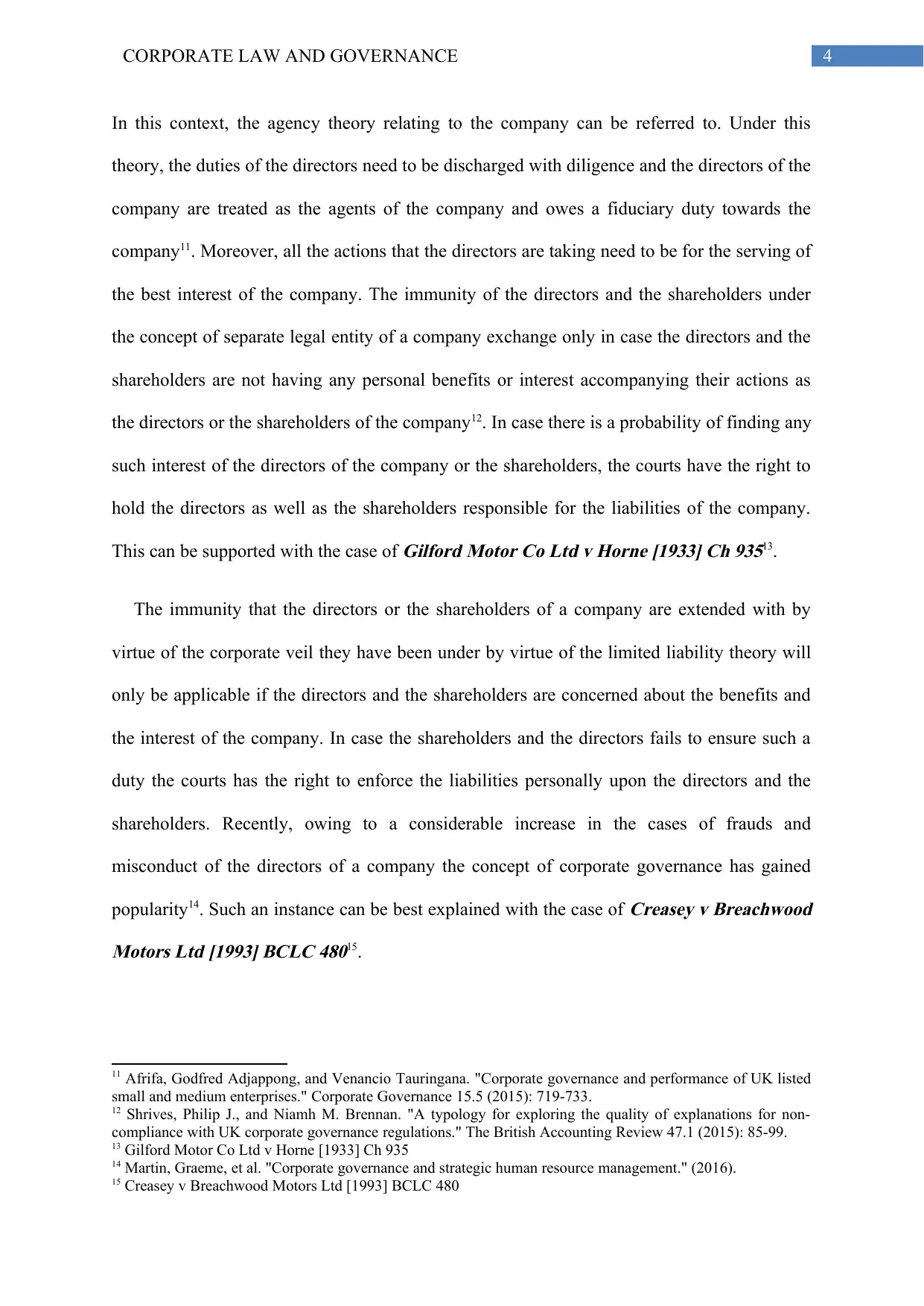
4CORPORATE LAW AND GOVERNANCE
In this context, the agency theory relating to the company can be referred to. Under this
theory, the duties of the directors need to be discharged with diligence and the directors of the
company are treated as the agents of the company and owes a fiduciary duty towards the
company11. Moreover, all the actions that the directors are taking need to be for the serving of
the best interest of the company. The immunity of the directors and the shareholders under
the concept of separate legal entity of a company exchange only in case the directors and the
shareholders are not having any personal benefits or interest accompanying their actions as
the directors or the shareholders of the company12. In case there is a probability of finding any
such interest of the directors of the company or the shareholders, the courts have the right to
hold the directors as well as the shareholders responsible for the liabilities of the company.
This can be supported with the case of
Gilford Motor Co Ltd v Horne [1933] Ch 93513.
The immunity that the directors or the shareholders of a company are extended with by
virtue of the corporate veil they have been under by virtue of the limited liability theory will
only be applicable if the directors and the shareholders are concerned about the benefits and
the interest of the company. In case the shareholders and the directors fails to ensure such a
duty the courts has the right to enforce the liabilities personally upon the directors and the
shareholders. Recently, owing to a considerable increase in the cases of frauds and
misconduct of the directors of a company the concept of corporate governance has gained
popularity14. Such an instance can be best explained with the case of
Creasey v Breachwood
Motors Ltd [1993] BCLC 48015.
11 Afrifa, Godfred Adjappong, and Venancio Tauringana. "Corporate governance and performance of UK listed
small and medium enterprises." Corporate Governance 15.5 (2015): 719-733.
12 Shrives, Philip J., and Niamh M. Brennan. "A typology for exploring the quality of explanations for non-
compliance with UK corporate governance regulations." The British Accounting Review 47.1 (2015): 85-99.
13 Gilford Motor Co Ltd v Horne [1933] Ch 935
14 Martin, Graeme, et al. "Corporate governance and strategic human resource management." (2016).
15 Creasey v Breachwood Motors Ltd [1993] BCLC 480
In this context, the agency theory relating to the company can be referred to. Under this
theory, the duties of the directors need to be discharged with diligence and the directors of the
company are treated as the agents of the company and owes a fiduciary duty towards the
company11. Moreover, all the actions that the directors are taking need to be for the serving of
the best interest of the company. The immunity of the directors and the shareholders under
the concept of separate legal entity of a company exchange only in case the directors and the
shareholders are not having any personal benefits or interest accompanying their actions as
the directors or the shareholders of the company12. In case there is a probability of finding any
such interest of the directors of the company or the shareholders, the courts have the right to
hold the directors as well as the shareholders responsible for the liabilities of the company.
This can be supported with the case of
Gilford Motor Co Ltd v Horne [1933] Ch 93513.
The immunity that the directors or the shareholders of a company are extended with by
virtue of the corporate veil they have been under by virtue of the limited liability theory will
only be applicable if the directors and the shareholders are concerned about the benefits and
the interest of the company. In case the shareholders and the directors fails to ensure such a
duty the courts has the right to enforce the liabilities personally upon the directors and the
shareholders. Recently, owing to a considerable increase in the cases of frauds and
misconduct of the directors of a company the concept of corporate governance has gained
popularity14. Such an instance can be best explained with the case of
Creasey v Breachwood
Motors Ltd [1993] BCLC 48015.
11 Afrifa, Godfred Adjappong, and Venancio Tauringana. "Corporate governance and performance of UK listed
small and medium enterprises." Corporate Governance 15.5 (2015): 719-733.
12 Shrives, Philip J., and Niamh M. Brennan. "A typology for exploring the quality of explanations for non-
compliance with UK corporate governance regulations." The British Accounting Review 47.1 (2015): 85-99.
13 Gilford Motor Co Ltd v Horne [1933] Ch 935
14 Martin, Graeme, et al. "Corporate governance and strategic human resource management." (2016).
15 Creasey v Breachwood Motors Ltd [1993] BCLC 480
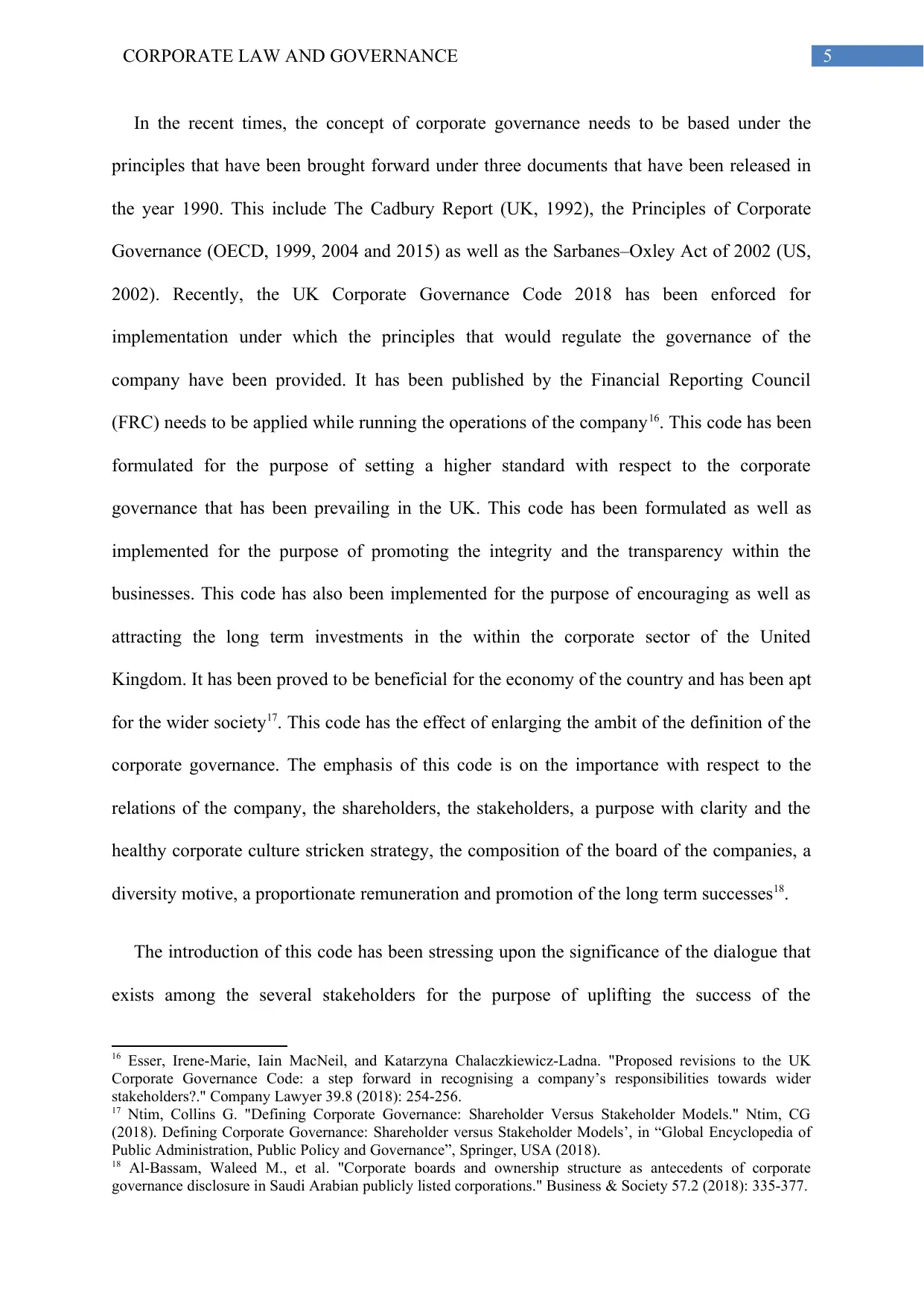
5CORPORATE LAW AND GOVERNANCE
In the recent times, the concept of corporate governance needs to be based under the
principles that have been brought forward under three documents that have been released in
the year 1990. This include The Cadbury Report (UK, 1992), the Principles of Corporate
Governance (OECD, 1999, 2004 and 2015) as well as the Sarbanes–Oxley Act of 2002 (US,
2002). Recently, the UK Corporate Governance Code 2018 has been enforced for
implementation under which the principles that would regulate the governance of the
company have been provided. It has been published by the Financial Reporting Council
(FRC) needs to be applied while running the operations of the company16. This code has been
formulated for the purpose of setting a higher standard with respect to the corporate
governance that has been prevailing in the UK. This code has been formulated as well as
implemented for the purpose of promoting the integrity and the transparency within the
businesses. This code has also been implemented for the purpose of encouraging as well as
attracting the long term investments in the within the corporate sector of the United
Kingdom. It has been proved to be beneficial for the economy of the country and has been apt
for the wider society17. This code has the effect of enlarging the ambit of the definition of the
corporate governance. The emphasis of this code is on the importance with respect to the
relations of the company, the shareholders, the stakeholders, a purpose with clarity and the
healthy corporate culture stricken strategy, the composition of the board of the companies, a
diversity motive, a proportionate remuneration and promotion of the long term successes18.
The introduction of this code has been stressing upon the significance of the dialogue that
exists among the several stakeholders for the purpose of uplifting the success of the
16 Esser, Irene-Marie, Iain MacNeil, and Katarzyna Chalaczkiewicz-Ladna. "Proposed revisions to the UK
Corporate Governance Code: a step forward in recognising a company’s responsibilities towards wider
stakeholders?." Company Lawyer 39.8 (2018): 254-256.
17 Ntim, Collins G. "Defining Corporate Governance: Shareholder Versus Stakeholder Models." Ntim, CG
(2018). Defining Corporate Governance: Shareholder versus Stakeholder Models’, in “Global Encyclopedia of
Public Administration, Public Policy and Governance”, Springer, USA (2018).
18 Al-Bassam, Waleed M., et al. "Corporate boards and ownership structure as antecedents of corporate
governance disclosure in Saudi Arabian publicly listed corporations." Business & Society 57.2 (2018): 335-377.
In the recent times, the concept of corporate governance needs to be based under the
principles that have been brought forward under three documents that have been released in
the year 1990. This include The Cadbury Report (UK, 1992), the Principles of Corporate
Governance (OECD, 1999, 2004 and 2015) as well as the Sarbanes–Oxley Act of 2002 (US,
2002). Recently, the UK Corporate Governance Code 2018 has been enforced for
implementation under which the principles that would regulate the governance of the
company have been provided. It has been published by the Financial Reporting Council
(FRC) needs to be applied while running the operations of the company16. This code has been
formulated for the purpose of setting a higher standard with respect to the corporate
governance that has been prevailing in the UK. This code has been formulated as well as
implemented for the purpose of promoting the integrity and the transparency within the
businesses. This code has also been implemented for the purpose of encouraging as well as
attracting the long term investments in the within the corporate sector of the United
Kingdom. It has been proved to be beneficial for the economy of the country and has been apt
for the wider society17. This code has the effect of enlarging the ambit of the definition of the
corporate governance. The emphasis of this code is on the importance with respect to the
relations of the company, the shareholders, the stakeholders, a purpose with clarity and the
healthy corporate culture stricken strategy, the composition of the board of the companies, a
diversity motive, a proportionate remuneration and promotion of the long term successes18.
The introduction of this code has been stressing upon the significance of the dialogue that
exists among the several stakeholders for the purpose of uplifting the success of the
16 Esser, Irene-Marie, Iain MacNeil, and Katarzyna Chalaczkiewicz-Ladna. "Proposed revisions to the UK
Corporate Governance Code: a step forward in recognising a company’s responsibilities towards wider
stakeholders?." Company Lawyer 39.8 (2018): 254-256.
17 Ntim, Collins G. "Defining Corporate Governance: Shareholder Versus Stakeholder Models." Ntim, CG
(2018). Defining Corporate Governance: Shareholder versus Stakeholder Models’, in “Global Encyclopedia of
Public Administration, Public Policy and Governance”, Springer, USA (2018).
18 Al-Bassam, Waleed M., et al. "Corporate boards and ownership structure as antecedents of corporate
governance disclosure in Saudi Arabian publicly listed corporations." Business & Society 57.2 (2018): 335-377.
You're viewing a preview
Unlock full access by subscribing today!
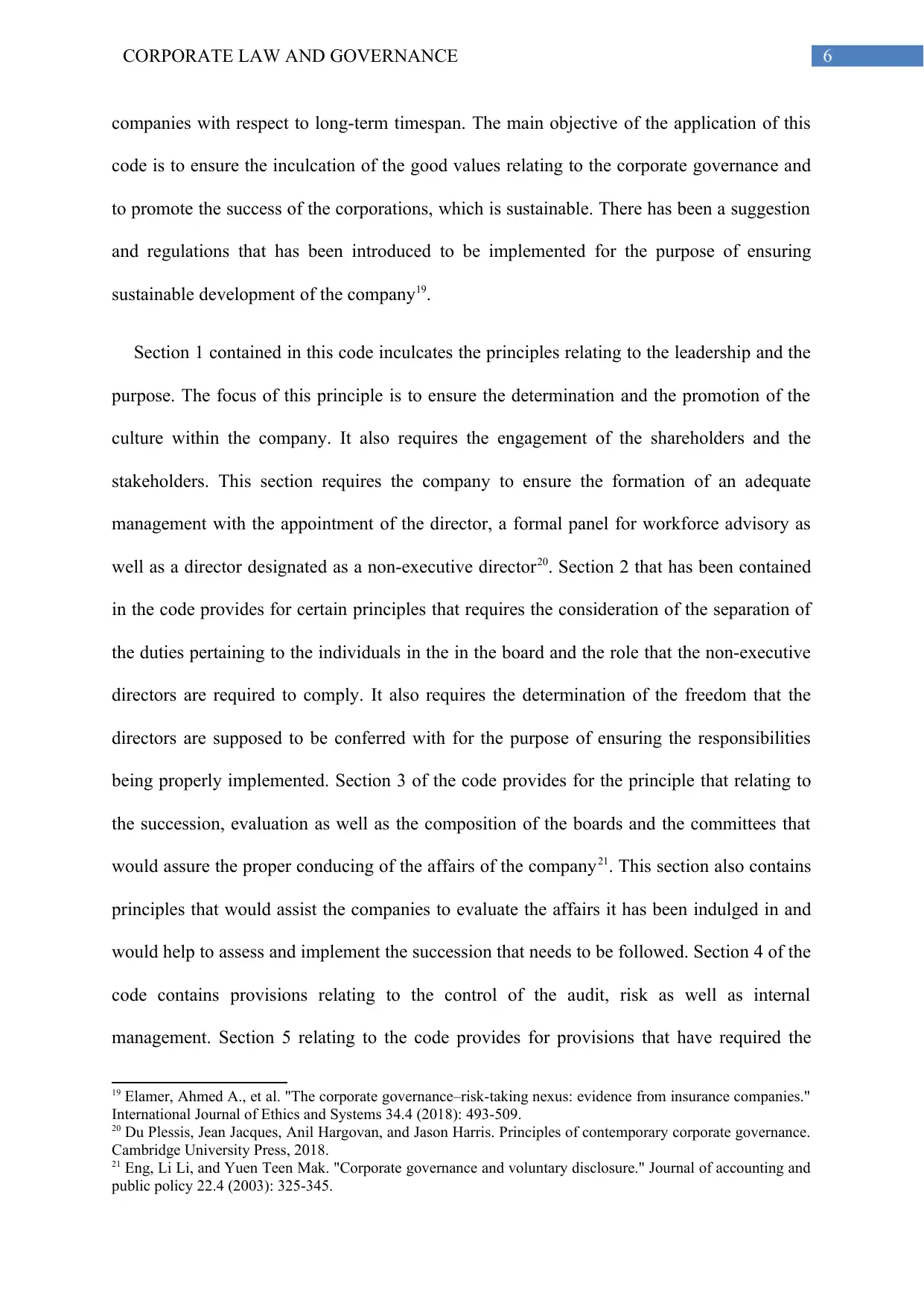
6CORPORATE LAW AND GOVERNANCE
companies with respect to long-term timespan. The main objective of the application of this
code is to ensure the inculcation of the good values relating to the corporate governance and
to promote the success of the corporations, which is sustainable. There has been a suggestion
and regulations that has been introduced to be implemented for the purpose of ensuring
sustainable development of the company19.
Section 1 contained in this code inculcates the principles relating to the leadership and the
purpose. The focus of this principle is to ensure the determination and the promotion of the
culture within the company. It also requires the engagement of the shareholders and the
stakeholders. This section requires the company to ensure the formation of an adequate
management with the appointment of the director, a formal panel for workforce advisory as
well as a director designated as a non-executive director20. Section 2 that has been contained
in the code provides for certain principles that requires the consideration of the separation of
the duties pertaining to the individuals in the in the board and the role that the non-executive
directors are required to comply. It also requires the determination of the freedom that the
directors are supposed to be conferred with for the purpose of ensuring the responsibilities
being properly implemented. Section 3 of the code provides for the principle that relating to
the succession, evaluation as well as the composition of the boards and the committees that
would assure the proper conducing of the affairs of the company21. This section also contains
principles that would assist the companies to evaluate the affairs it has been indulged in and
would help to assess and implement the succession that needs to be followed. Section 4 of the
code contains provisions relating to the control of the audit, risk as well as internal
management. Section 5 relating to the code provides for provisions that have required the
19 Elamer, Ahmed A., et al. "The corporate governance–risk-taking nexus: evidence from insurance companies."
International Journal of Ethics and Systems 34.4 (2018): 493-509.
20 Du Plessis, Jean Jacques, Anil Hargovan, and Jason Harris. Principles of contemporary corporate governance.
Cambridge University Press, 2018.
21 Eng, Li Li, and Yuen Teen Mak. "Corporate governance and voluntary disclosure." Journal of accounting and
public policy 22.4 (2003): 325-345.
companies with respect to long-term timespan. The main objective of the application of this
code is to ensure the inculcation of the good values relating to the corporate governance and
to promote the success of the corporations, which is sustainable. There has been a suggestion
and regulations that has been introduced to be implemented for the purpose of ensuring
sustainable development of the company19.
Section 1 contained in this code inculcates the principles relating to the leadership and the
purpose. The focus of this principle is to ensure the determination and the promotion of the
culture within the company. It also requires the engagement of the shareholders and the
stakeholders. This section requires the company to ensure the formation of an adequate
management with the appointment of the director, a formal panel for workforce advisory as
well as a director designated as a non-executive director20. Section 2 that has been contained
in the code provides for certain principles that requires the consideration of the separation of
the duties pertaining to the individuals in the in the board and the role that the non-executive
directors are required to comply. It also requires the determination of the freedom that the
directors are supposed to be conferred with for the purpose of ensuring the responsibilities
being properly implemented. Section 3 of the code provides for the principle that relating to
the succession, evaluation as well as the composition of the boards and the committees that
would assure the proper conducing of the affairs of the company21. This section also contains
principles that would assist the companies to evaluate the affairs it has been indulged in and
would help to assess and implement the succession that needs to be followed. Section 4 of the
code contains provisions relating to the control of the audit, risk as well as internal
management. Section 5 relating to the code provides for provisions that have required the
19 Elamer, Ahmed A., et al. "The corporate governance–risk-taking nexus: evidence from insurance companies."
International Journal of Ethics and Systems 34.4 (2018): 493-509.
20 Du Plessis, Jean Jacques, Anil Hargovan, and Jason Harris. Principles of contemporary corporate governance.
Cambridge University Press, 2018.
21 Eng, Li Li, and Yuen Teen Mak. "Corporate governance and voluntary disclosure." Journal of accounting and
public policy 22.4 (2003): 325-345.
Paraphrase This Document
Need a fresh take? Get an instant paraphrase of this document with our AI Paraphraser
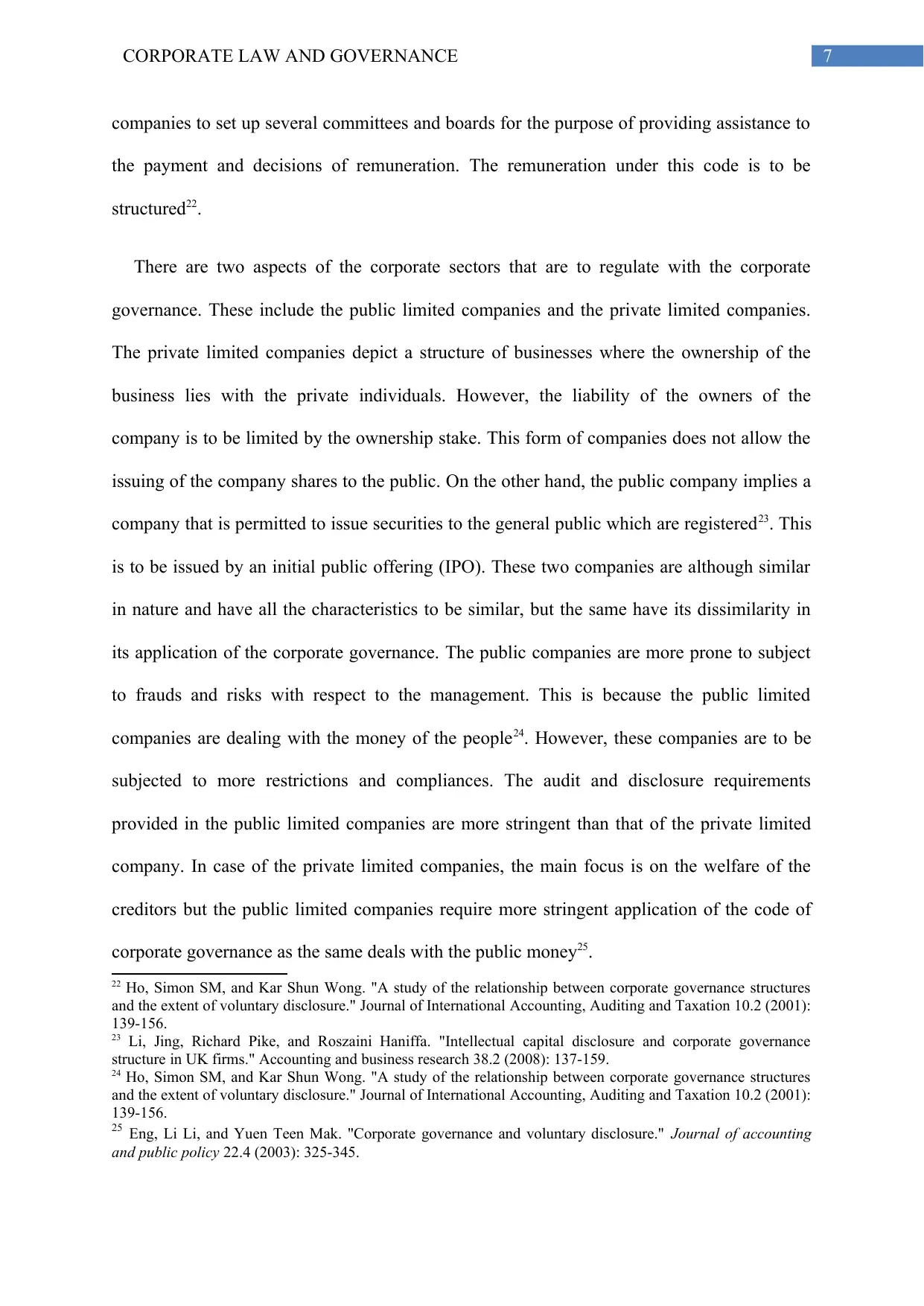
7CORPORATE LAW AND GOVERNANCE
companies to set up several committees and boards for the purpose of providing assistance to
the payment and decisions of remuneration. The remuneration under this code is to be
structured22.
There are two aspects of the corporate sectors that are to regulate with the corporate
governance. These include the public limited companies and the private limited companies.
The private limited companies depict a structure of businesses where the ownership of the
business lies with the private individuals. However, the liability of the owners of the
company is to be limited by the ownership stake. This form of companies does not allow the
issuing of the company shares to the public. On the other hand, the public company implies a
company that is permitted to issue securities to the general public which are registered23. This
is to be issued by an initial public offering (IPO). These two companies are although similar
in nature and have all the characteristics to be similar, but the same have its dissimilarity in
its application of the corporate governance. The public companies are more prone to subject
to frauds and risks with respect to the management. This is because the public limited
companies are dealing with the money of the people24. However, these companies are to be
subjected to more restrictions and compliances. The audit and disclosure requirements
provided in the public limited companies are more stringent than that of the private limited
company. In case of the private limited companies, the main focus is on the welfare of the
creditors but the public limited companies require more stringent application of the code of
corporate governance as the same deals with the public money25.
22 Ho, Simon SM, and Kar Shun Wong. "A study of the relationship between corporate governance structures
and the extent of voluntary disclosure." Journal of International Accounting, Auditing and Taxation 10.2 (2001):
139-156.
23 Li, Jing, Richard Pike, and Roszaini Haniffa. "Intellectual capital disclosure and corporate governance
structure in UK firms." Accounting and business research 38.2 (2008): 137-159.
24 Ho, Simon SM, and Kar Shun Wong. "A study of the relationship between corporate governance structures
and the extent of voluntary disclosure." Journal of International Accounting, Auditing and Taxation 10.2 (2001):
139-156.
25 Eng, Li Li, and Yuen Teen Mak. "Corporate governance and voluntary disclosure." Journal of accounting
and public policy 22.4 (2003): 325-345.
companies to set up several committees and boards for the purpose of providing assistance to
the payment and decisions of remuneration. The remuneration under this code is to be
structured22.
There are two aspects of the corporate sectors that are to regulate with the corporate
governance. These include the public limited companies and the private limited companies.
The private limited companies depict a structure of businesses where the ownership of the
business lies with the private individuals. However, the liability of the owners of the
company is to be limited by the ownership stake. This form of companies does not allow the
issuing of the company shares to the public. On the other hand, the public company implies a
company that is permitted to issue securities to the general public which are registered23. This
is to be issued by an initial public offering (IPO). These two companies are although similar
in nature and have all the characteristics to be similar, but the same have its dissimilarity in
its application of the corporate governance. The public companies are more prone to subject
to frauds and risks with respect to the management. This is because the public limited
companies are dealing with the money of the people24. However, these companies are to be
subjected to more restrictions and compliances. The audit and disclosure requirements
provided in the public limited companies are more stringent than that of the private limited
company. In case of the private limited companies, the main focus is on the welfare of the
creditors but the public limited companies require more stringent application of the code of
corporate governance as the same deals with the public money25.
22 Ho, Simon SM, and Kar Shun Wong. "A study of the relationship between corporate governance structures
and the extent of voluntary disclosure." Journal of International Accounting, Auditing and Taxation 10.2 (2001):
139-156.
23 Li, Jing, Richard Pike, and Roszaini Haniffa. "Intellectual capital disclosure and corporate governance
structure in UK firms." Accounting and business research 38.2 (2008): 137-159.
24 Ho, Simon SM, and Kar Shun Wong. "A study of the relationship between corporate governance structures
and the extent of voluntary disclosure." Journal of International Accounting, Auditing and Taxation 10.2 (2001):
139-156.
25 Eng, Li Li, and Yuen Teen Mak. "Corporate governance and voluntary disclosure." Journal of accounting
and public policy 22.4 (2003): 325-345.
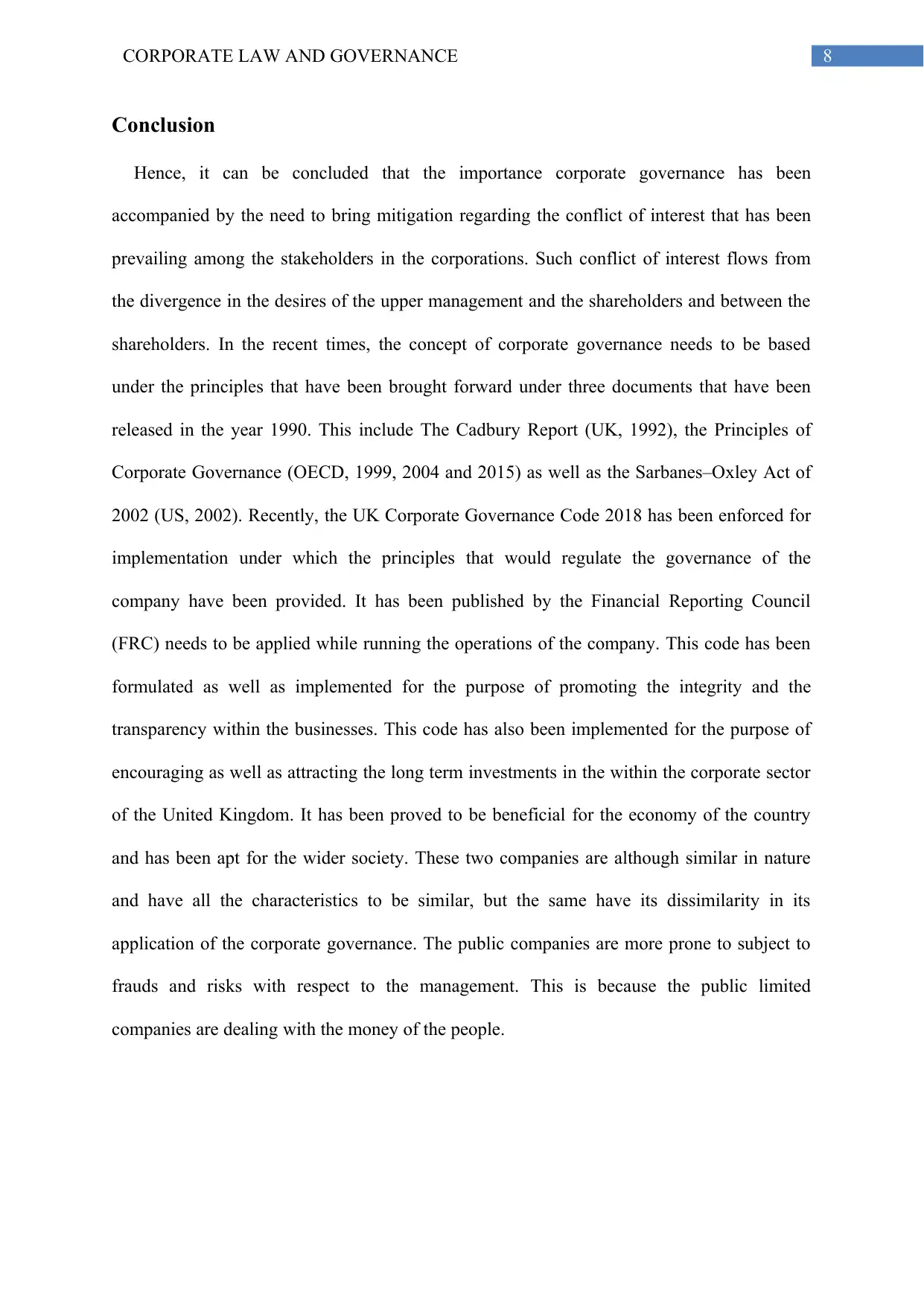
8CORPORATE LAW AND GOVERNANCE
Conclusion
Hence, it can be concluded that the importance corporate governance has been
accompanied by the need to bring mitigation regarding the conflict of interest that has been
prevailing among the stakeholders in the corporations. Such conflict of interest flows from
the divergence in the desires of the upper management and the shareholders and between the
shareholders. In the recent times, the concept of corporate governance needs to be based
under the principles that have been brought forward under three documents that have been
released in the year 1990. This include The Cadbury Report (UK, 1992), the Principles of
Corporate Governance (OECD, 1999, 2004 and 2015) as well as the Sarbanes–Oxley Act of
2002 (US, 2002). Recently, the UK Corporate Governance Code 2018 has been enforced for
implementation under which the principles that would regulate the governance of the
company have been provided. It has been published by the Financial Reporting Council
(FRC) needs to be applied while running the operations of the company. This code has been
formulated as well as implemented for the purpose of promoting the integrity and the
transparency within the businesses. This code has also been implemented for the purpose of
encouraging as well as attracting the long term investments in the within the corporate sector
of the United Kingdom. It has been proved to be beneficial for the economy of the country
and has been apt for the wider society. These two companies are although similar in nature
and have all the characteristics to be similar, but the same have its dissimilarity in its
application of the corporate governance. The public companies are more prone to subject to
frauds and risks with respect to the management. This is because the public limited
companies are dealing with the money of the people.
Conclusion
Hence, it can be concluded that the importance corporate governance has been
accompanied by the need to bring mitigation regarding the conflict of interest that has been
prevailing among the stakeholders in the corporations. Such conflict of interest flows from
the divergence in the desires of the upper management and the shareholders and between the
shareholders. In the recent times, the concept of corporate governance needs to be based
under the principles that have been brought forward under three documents that have been
released in the year 1990. This include The Cadbury Report (UK, 1992), the Principles of
Corporate Governance (OECD, 1999, 2004 and 2015) as well as the Sarbanes–Oxley Act of
2002 (US, 2002). Recently, the UK Corporate Governance Code 2018 has been enforced for
implementation under which the principles that would regulate the governance of the
company have been provided. It has been published by the Financial Reporting Council
(FRC) needs to be applied while running the operations of the company. This code has been
formulated as well as implemented for the purpose of promoting the integrity and the
transparency within the businesses. This code has also been implemented for the purpose of
encouraging as well as attracting the long term investments in the within the corporate sector
of the United Kingdom. It has been proved to be beneficial for the economy of the country
and has been apt for the wider society. These two companies are although similar in nature
and have all the characteristics to be similar, but the same have its dissimilarity in its
application of the corporate governance. The public companies are more prone to subject to
frauds and risks with respect to the management. This is because the public limited
companies are dealing with the money of the people.
You're viewing a preview
Unlock full access by subscribing today!
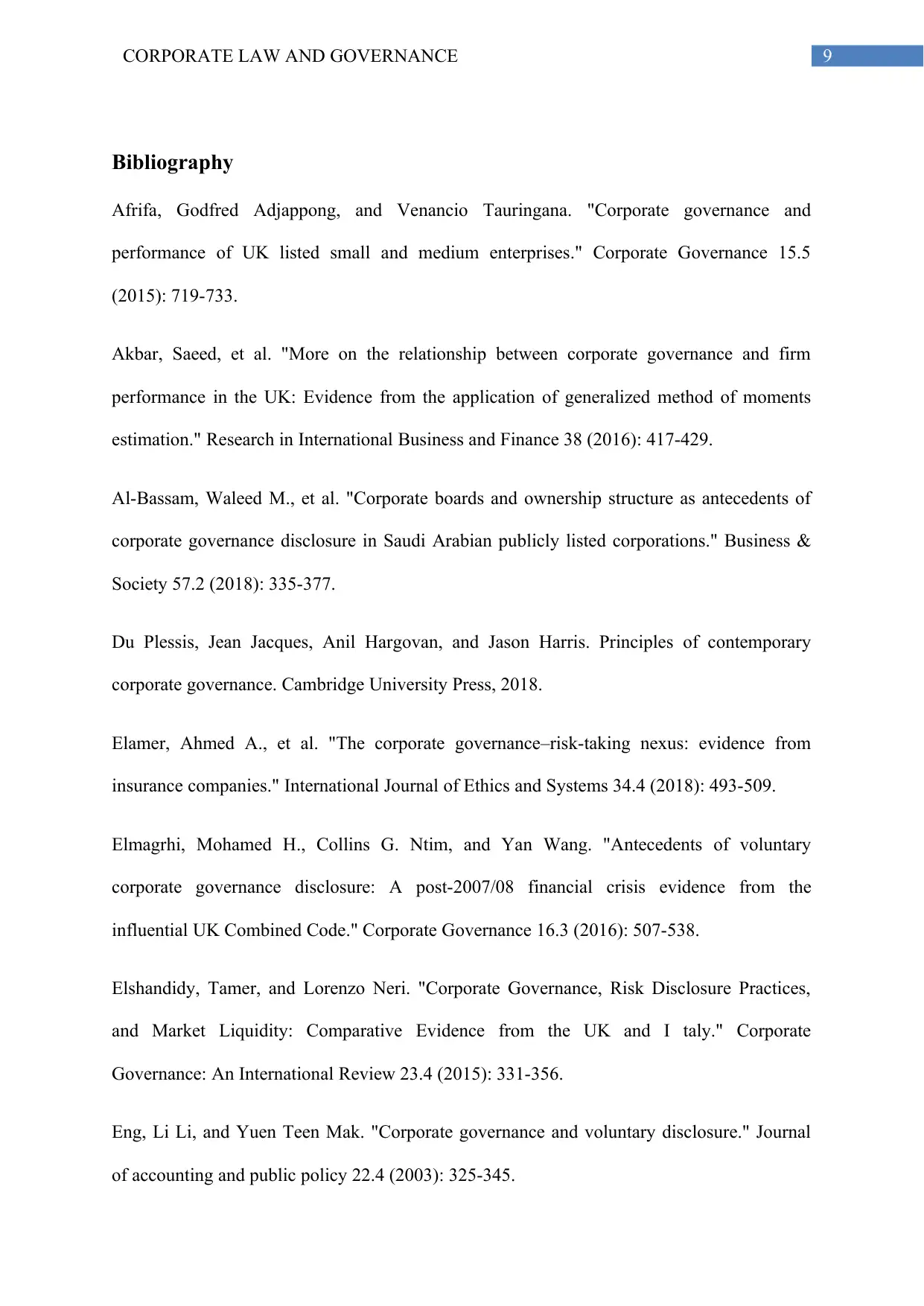
9CORPORATE LAW AND GOVERNANCE
Bibliography
Afrifa, Godfred Adjappong, and Venancio Tauringana. "Corporate governance and
performance of UK listed small and medium enterprises." Corporate Governance 15.5
(2015): 719-733.
Akbar, Saeed, et al. "More on the relationship between corporate governance and firm
performance in the UK: Evidence from the application of generalized method of moments
estimation." Research in International Business and Finance 38 (2016): 417-429.
Al-Bassam, Waleed M., et al. "Corporate boards and ownership structure as antecedents of
corporate governance disclosure in Saudi Arabian publicly listed corporations." Business &
Society 57.2 (2018): 335-377.
Du Plessis, Jean Jacques, Anil Hargovan, and Jason Harris. Principles of contemporary
corporate governance. Cambridge University Press, 2018.
Elamer, Ahmed A., et al. "The corporate governance–risk-taking nexus: evidence from
insurance companies." International Journal of Ethics and Systems 34.4 (2018): 493-509.
Elmagrhi, Mohamed H., Collins G. Ntim, and Yan Wang. "Antecedents of voluntary
corporate governance disclosure: A post-2007/08 financial crisis evidence from the
influential UK Combined Code." Corporate Governance 16.3 (2016): 507-538.
Elshandidy, Tamer, and Lorenzo Neri. "Corporate Governance, Risk Disclosure Practices,
and Market Liquidity: Comparative Evidence from the UK and I taly." Corporate
Governance: An International Review 23.4 (2015): 331-356.
Eng, Li Li, and Yuen Teen Mak. "Corporate governance and voluntary disclosure." Journal
of accounting and public policy 22.4 (2003): 325-345.
Bibliography
Afrifa, Godfred Adjappong, and Venancio Tauringana. "Corporate governance and
performance of UK listed small and medium enterprises." Corporate Governance 15.5
(2015): 719-733.
Akbar, Saeed, et al. "More on the relationship between corporate governance and firm
performance in the UK: Evidence from the application of generalized method of moments
estimation." Research in International Business and Finance 38 (2016): 417-429.
Al-Bassam, Waleed M., et al. "Corporate boards and ownership structure as antecedents of
corporate governance disclosure in Saudi Arabian publicly listed corporations." Business &
Society 57.2 (2018): 335-377.
Du Plessis, Jean Jacques, Anil Hargovan, and Jason Harris. Principles of contemporary
corporate governance. Cambridge University Press, 2018.
Elamer, Ahmed A., et al. "The corporate governance–risk-taking nexus: evidence from
insurance companies." International Journal of Ethics and Systems 34.4 (2018): 493-509.
Elmagrhi, Mohamed H., Collins G. Ntim, and Yan Wang. "Antecedents of voluntary
corporate governance disclosure: A post-2007/08 financial crisis evidence from the
influential UK Combined Code." Corporate Governance 16.3 (2016): 507-538.
Elshandidy, Tamer, and Lorenzo Neri. "Corporate Governance, Risk Disclosure Practices,
and Market Liquidity: Comparative Evidence from the UK and I taly." Corporate
Governance: An International Review 23.4 (2015): 331-356.
Eng, Li Li, and Yuen Teen Mak. "Corporate governance and voluntary disclosure." Journal
of accounting and public policy 22.4 (2003): 325-345.
Paraphrase This Document
Need a fresh take? Get an instant paraphrase of this document with our AI Paraphraser
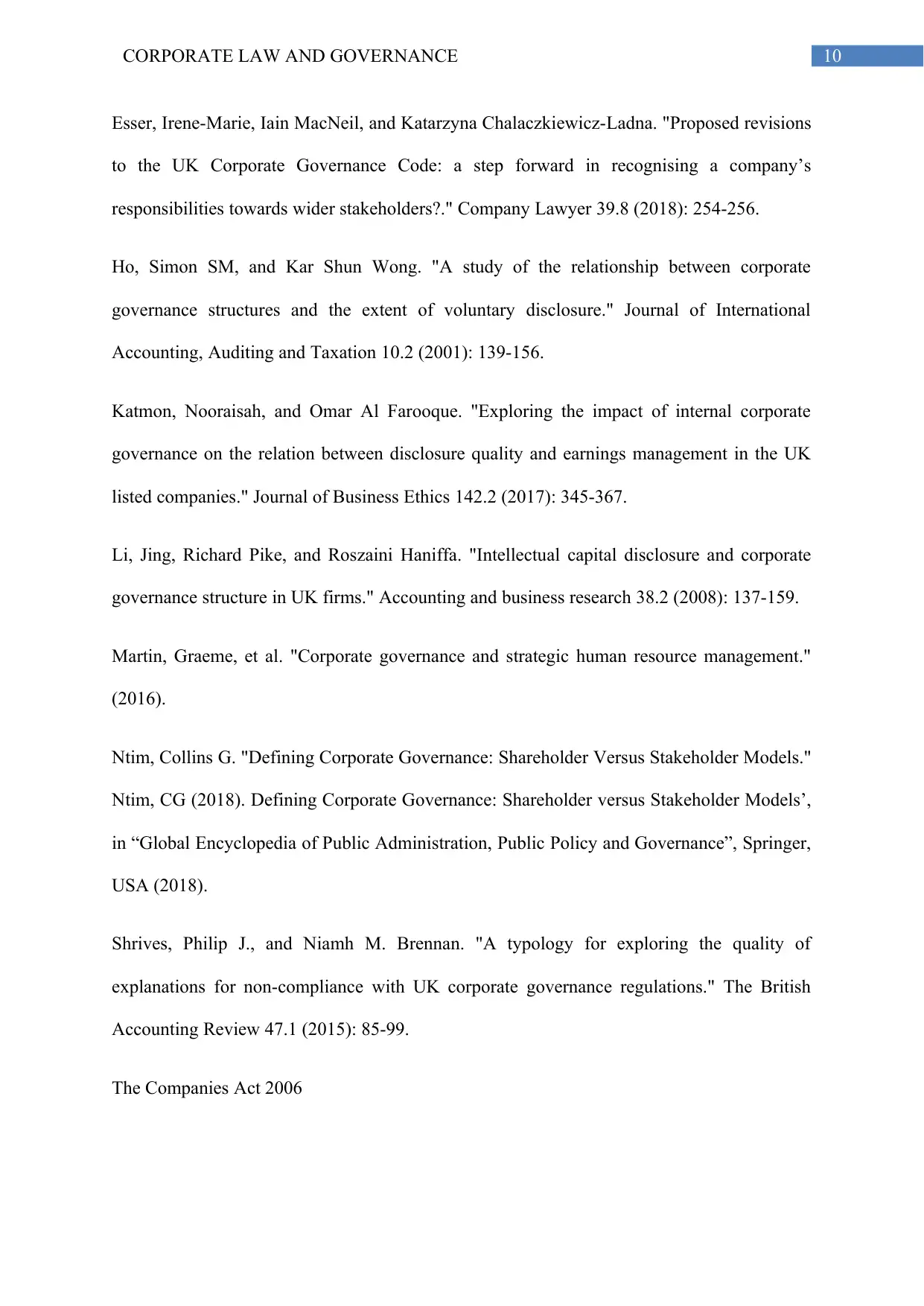
10CORPORATE LAW AND GOVERNANCE
Esser, Irene-Marie, Iain MacNeil, and Katarzyna Chalaczkiewicz-Ladna. "Proposed revisions
to the UK Corporate Governance Code: a step forward in recognising a company’s
responsibilities towards wider stakeholders?." Company Lawyer 39.8 (2018): 254-256.
Ho, Simon SM, and Kar Shun Wong. "A study of the relationship between corporate
governance structures and the extent of voluntary disclosure." Journal of International
Accounting, Auditing and Taxation 10.2 (2001): 139-156.
Katmon, Nooraisah, and Omar Al Farooque. "Exploring the impact of internal corporate
governance on the relation between disclosure quality and earnings management in the UK
listed companies." Journal of Business Ethics 142.2 (2017): 345-367.
Li, Jing, Richard Pike, and Roszaini Haniffa. "Intellectual capital disclosure and corporate
governance structure in UK firms." Accounting and business research 38.2 (2008): 137-159.
Martin, Graeme, et al. "Corporate governance and strategic human resource management."
(2016).
Ntim, Collins G. "Defining Corporate Governance: Shareholder Versus Stakeholder Models."
Ntim, CG (2018). Defining Corporate Governance: Shareholder versus Stakeholder Models’,
in “Global Encyclopedia of Public Administration, Public Policy and Governance”, Springer,
USA (2018).
Shrives, Philip J., and Niamh M. Brennan. "A typology for exploring the quality of
explanations for non-compliance with UK corporate governance regulations." The British
Accounting Review 47.1 (2015): 85-99.
The Companies Act 2006
Esser, Irene-Marie, Iain MacNeil, and Katarzyna Chalaczkiewicz-Ladna. "Proposed revisions
to the UK Corporate Governance Code: a step forward in recognising a company’s
responsibilities towards wider stakeholders?." Company Lawyer 39.8 (2018): 254-256.
Ho, Simon SM, and Kar Shun Wong. "A study of the relationship between corporate
governance structures and the extent of voluntary disclosure." Journal of International
Accounting, Auditing and Taxation 10.2 (2001): 139-156.
Katmon, Nooraisah, and Omar Al Farooque. "Exploring the impact of internal corporate
governance on the relation between disclosure quality and earnings management in the UK
listed companies." Journal of Business Ethics 142.2 (2017): 345-367.
Li, Jing, Richard Pike, and Roszaini Haniffa. "Intellectual capital disclosure and corporate
governance structure in UK firms." Accounting and business research 38.2 (2008): 137-159.
Martin, Graeme, et al. "Corporate governance and strategic human resource management."
(2016).
Ntim, Collins G. "Defining Corporate Governance: Shareholder Versus Stakeholder Models."
Ntim, CG (2018). Defining Corporate Governance: Shareholder versus Stakeholder Models’,
in “Global Encyclopedia of Public Administration, Public Policy and Governance”, Springer,
USA (2018).
Shrives, Philip J., and Niamh M. Brennan. "A typology for exploring the quality of
explanations for non-compliance with UK corporate governance regulations." The British
Accounting Review 47.1 (2015): 85-99.
The Companies Act 2006
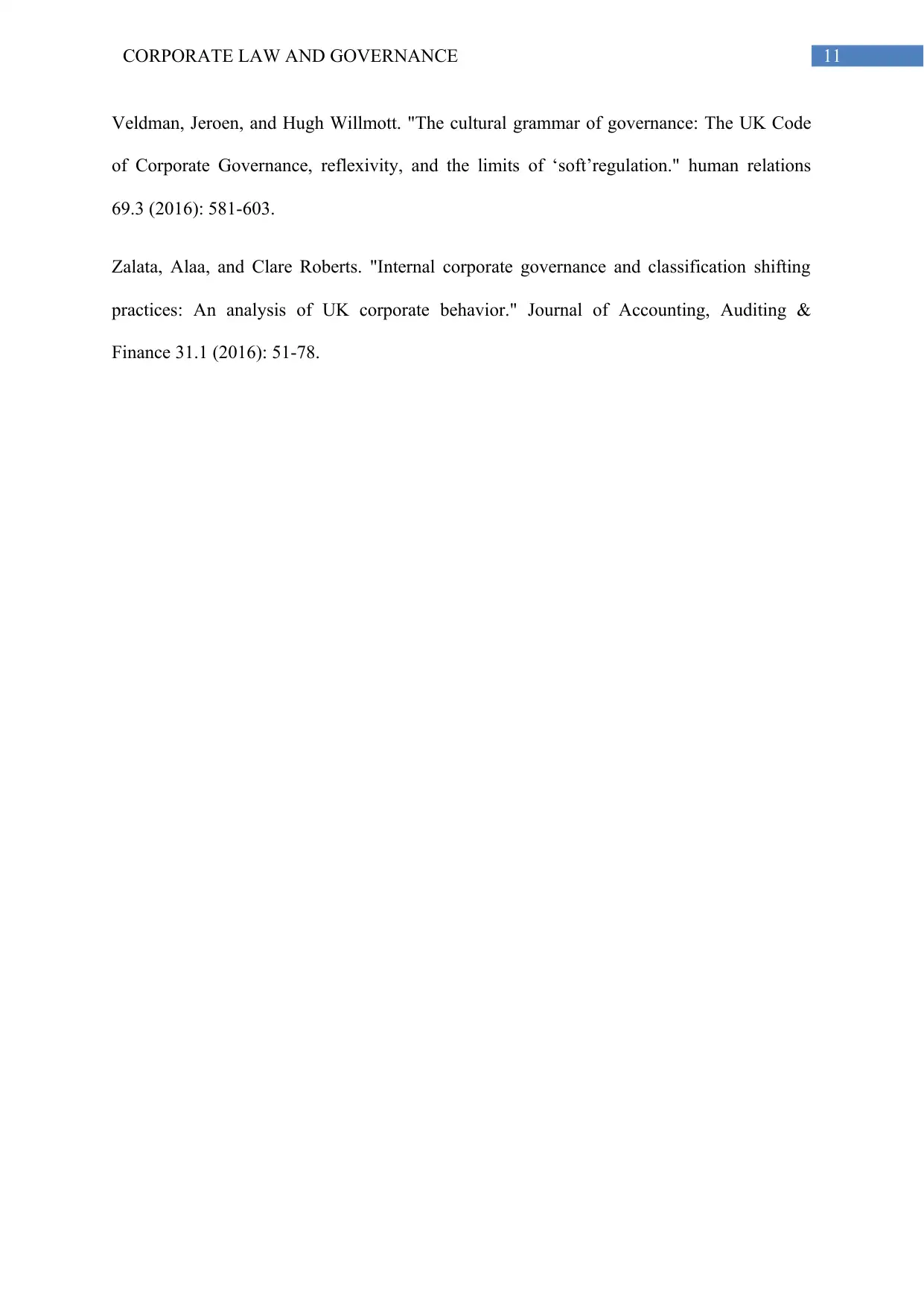
11CORPORATE LAW AND GOVERNANCE
Veldman, Jeroen, and Hugh Willmott. "The cultural grammar of governance: The UK Code
of Corporate Governance, reflexivity, and the limits of ‘soft’regulation." human relations
69.3 (2016): 581-603.
Zalata, Alaa, and Clare Roberts. "Internal corporate governance and classification shifting
practices: An analysis of UK corporate behavior." Journal of Accounting, Auditing &
Finance 31.1 (2016): 51-78.
Veldman, Jeroen, and Hugh Willmott. "The cultural grammar of governance: The UK Code
of Corporate Governance, reflexivity, and the limits of ‘soft’regulation." human relations
69.3 (2016): 581-603.
Zalata, Alaa, and Clare Roberts. "Internal corporate governance and classification shifting
practices: An analysis of UK corporate behavior." Journal of Accounting, Auditing &
Finance 31.1 (2016): 51-78.
You're viewing a preview
Unlock full access by subscribing today!
1 out of 12
Related Documents
Your All-in-One AI-Powered Toolkit for Academic Success.
+13062052269
info@desklib.com
Available 24*7 on WhatsApp / Email
![[object Object]](/_next/static/media/star-bottom.7253800d.svg)
Unlock your academic potential
© 2024 | Zucol Services PVT LTD | All rights reserved.





